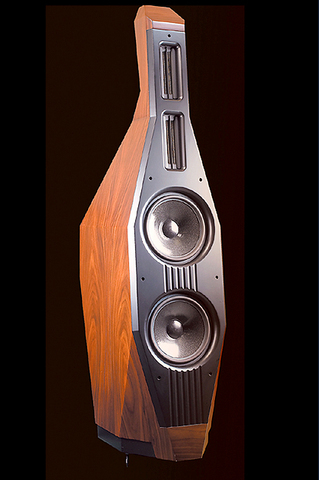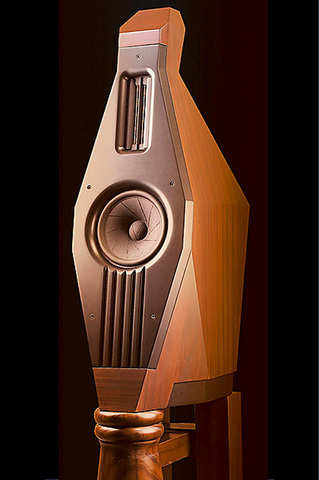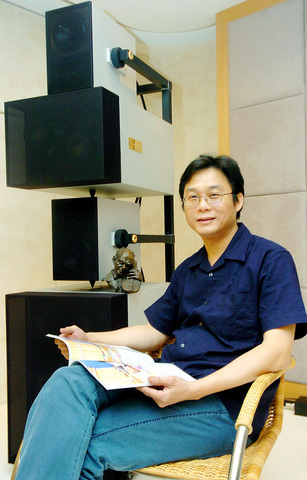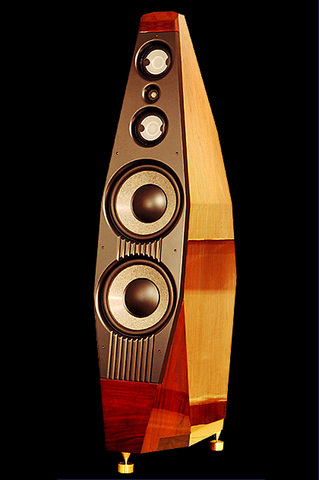The IFA consumer electronics fair in Berlin last week assembled what it called the most expensive hi-fi in the world. That sounded like a fun thing to do, so I decided to go in search of a superlative of my own: the best home audio hi-fi for my NT dollar.
"That's a lot like asking what's the best car in the world," said Jason Ma (
Ma's outfit took best-of-show at the Taiwan Audio Association's International Hi-End Hi-Fi Show in Xindian (新店) last month, quite an honor for an event that fills several floors of a hotel each year with hundreds of exhibitors. The show's winning speakers were a pair of Wilson Audio's flagship Alexandria X-2, six-driver loudspeakers constructed from a material known only as "X" that is harder and heavier than steel. A pair takes six weeks to manufacture.

"Wilson makes arguably the best speaker. From tuner to speaker, Goldmund makes the best complete hi-fi system in the world," Ma said.
He explained that many speaker designers work to craft a product made to play certain types of music and this is especially true of hi-end equipment. Here, the designers' target audience is audiophiles interested in obtaining perfect reproductions of their most treasured concert recordings -- usually opera or classical music.
"When the musicians are trying to achieve perfection and the recording engineer was working for absolute clarity, those are the recordings for which high-end audio equipment is made," Ma said. "These speakers aren't made to go in, say, a nightclub because electronic music and hip hop don't require the kind of definition these speakers offer. You just need a lot of volume and a lot of bass."

Understanding the design of the product is key to understanding why it sounds as good as it does, Ma said.
"Designers might try using a variety of woods to build a speaker, first trying them in one way, then another, or in using combinations of wood," he said. "When you start to hear the difference in sound created by different woods -- like the way a wine lover tastes a variety of flavors in a single glass -- then you're becoming an audiophile."
Goldmund eschews wood in its speakers because, as Ma explained, woods take on a life of their own in an acoustic environment, often vibrating differently than what is intended and producing an unwanted ambient noise.

PHOTO: CHANG CHIA-MING, TAIPEI TIMES
Though design is integral to sound quality it can also be purely cosmetic. While gold is an excellent design choice for a speaker or tuner's fittings because it is an excellent conductor of electricity, a gold-plated volume knob only adds to the price tag, not the sound quality.
Think you're ready to upgrade to one of the world's best home hi-fis? Before you can lay back in your Lazy Boy and enjoy your new stereo you'll have to listen first to an altogether less pleasant sound: the cash register. The Wilson Alexandria X-2s in Ma's back showroom cost NT$4.5 million.
The front showroom Goldmund Epilogue 1 speaker system is NT$9 million. It includes two speakers, each with 12 drivers, and a pair of amplifiers to power them. The system bandwidth extends from below 20Hz to more than 28kHz. Goldmund is famous for never listening to its products before marketing them. Rather, each instrument undergoes several scientific measurements to make sure it meets intended benchmarks. The human ear, they say, cannot hear the truth.

PHOTOS COURTESY OF LAWRENCE AUDIO.
Of course, there are cheaper alternatives and some are locally made. Horntex Audio Lab owner and sole employee Hong Renn-yow (
"I make 2,000 tweeters and 2,000 mid-range speakers every year by myself," Hong said. "I make 500 woofers and hundreds of amps every year -- just one man!"
Acoustician Lawrence Liao
(
Putting on a CD of Tchaikovsky in his showroom, Liao echoed Ma's sentiments regarding music and music reproduction. A music system, he said, is only good as the music you play on it.
"If you're looking for the best system on which to play your compressed MP3 files, you're better off looking at a computer store."

Even by the standards of Ukraine’s International Legion, which comprises volunteers from over 55 countries, Han has an unusual backstory. Born in Taichung, he grew up in Costa Rica — then one of Taiwan’s diplomatic allies — where a relative worked for the embassy. After attending an American international high school in San Jose, Costa Rica’s capital, Han — who prefers to use only his given name for OPSEC (operations security) reasons — moved to the US in his teens. He attended Penn State University before returning to Taiwan to work in the semiconductor industry in Kaohsiung, where he

On May 2, Chinese Nationalist Party (KMT) Chairman Eric Chu (朱立倫), at a meeting in support of Taipei city councilors at party headquarters, compared President William Lai (賴清德) to Hitler. Chu claimed that unlike any other democracy worldwide in history, no other leader was rooting out opposing parties like Lai and the Democratic Progressive Party (DPP). That his statements are wildly inaccurate was not the point. It was a rallying cry, not a history lesson. This was intentional to provoke the international diplomatic community into a response, which was promptly provided. Both the German and Israeli offices issued statements on Facebook

May 18 to May 24 Pastor Yang Hsu’s (楊煦) congregation was shocked upon seeing the land he chose to build his orphanage. It was surrounded by mountains on three sides, and the only way to access it was to cross a river by foot. The soil was poor due to runoff, and large rocks strewn across the plot prevented much from growing. In addition, there was no running water or electricity. But it was all Yang could afford. He and his Indigenous Atayal wife Lin Feng-ying (林鳳英) had already been caring for 24 orphans in their home, and they were in

Australia’s ABC last week published a piece on the recall campaign. The article emphasized the divisions in Taiwanese society and blamed the recall for worsening them. It quotes a supporter of the Taiwan People’s Party (TPP) as saying “I’m 43 years old, born and raised here, and I’ve never seen the country this divided in my entire life.” Apparently, as an adult, she slept through the post-election violence in 2000 and 2004 by the Chinese Nationalist Party (KMT), the veiled coup threats by the military when Chen Shui-bian (陳水扁) became president, the 2006 Red Shirt protests against him ginned up by